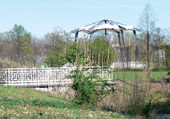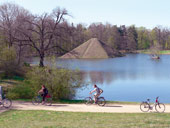Branitz park landscape
There are three parks to the right of the trail. In the zoo (3) which opened in 1954 there are 1.100 animals. Besides the exotic ones like gibbons, suricates, and elephants the employees are very eager in breeding water(!)fowls. The zoo uses the nearby Spree to create a magnificent landscape. After the zoo you reach the Spreeauenpark (Spree Floodplain Park), which is located on the core of the German Federal Garden Show (BUGA) of 1995 (4).
With its rosery, a rhododendron grove, a rare tertiary wood and an artificial lake it is always a nice place to stop by. The lake gets fresh water supply from an old Spree arm.
If you want to enter the park you have to pay a little mite for the maintenance. Before the BUGA was prepared the area was sealed and paved and driving schools practiced here.
The third one is Branitz Park (5). You can also reach it by bike. Branitz Park is one of the most beautiful ones in Europe.
It was created by the gifted landscape designer, globetrotter, and man of letters Hermann Prince of Pückler-Muskau (1785-1871). Pückler had a unique feeling for composing landscape parks. His design elements were big lawns, groups of trees, water, ways and buildings. Water was a necessary element in all means: as a glittering lake where trees, bushes, and buildings are mirroring or as a rippling creek or as a fountain.
Pückler knew how to create supplemental appeals for the eye.
When Pückler had to sell castle and park in Muskau for financial reasons, he moved to castle Branitz, an old family heritage that he had not taken much care of before. Before Pückler came, the park was an even sandy area. The Spree was flowing around it in a big bow. Immediately, he started working to create a park. In 1847 he wrote to his wife Lucie about his works: "What happens with the park after our death is a minor matter.
Nothing is eternal, but eternally creating is godly."
Since the ground water level is quite high due to the nearby Spree, little lakes emerged when holes were dug. An artificial inflow contributed to a harmonic water landscape. In the greatest lake Pückler built a tumulus (6), a burial site that combined cairns of the Bronze Age with the gravesites of the pharaohs. Pückler ordered to be buried there. The "Foundation Park and Castle Pückler" is conserving the heritage of the significant garden artist.



